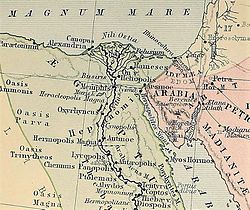Cynopolis
| Cynopolis | |
|---|---|
| Town | |
| Etymology: "City of the dog" | |
 A map of Ancient Egypt |
Cynopolis (Greek for "city of the dog") was the Hellenistic toponym for two cities in Ancient Egypt. Both Cynopolis superior and Cynopolis inferior were bishoprics in Christian times.
Cynopolis was the Greek name for the ancient Egyptian town of Hardai in the seventeenth nome of Upper Egypt, was home to the cult of Anubis, a canine-shaped deity. According to Claudius Ptolemy, the town was situated on an island in the river. The modern settlement of El Kays now stands on the site. The nome of Cynopolis extended to both banks of the Nile.
A burial ground for dogs was discovered on the opposite bank of the Nile, near Hamatha. The neighbouring cities were rivals according to Plutarch, who wrote (De Iside, 72) that when an Cynopolis resident ate an Oxyrhynchos fish, the people of Oxyrhynchos started attacking dogs in revenge, which resulted in a minor civil war.
Cynopolis was destroyed by the viceroy of Nubia Pinehesy during the reign of Ramses XI: the survivors were enslaved.
The diocese, which became obscure under Islam, was nominally restored in 1933 as a Latin Catholic titular bishopric. It was named Cynopolis in Aegypto. The see has been vacant for several decades, having had the following incumbents, both of the lowest (episcopal) rank:
There was a second Cynopolis, referred to as Cynopolis Inferior or Cynum, which was located in the Busirite nome in Lower Egypt (the Nile delta), now modern Meniet ebn Kasib. It was a suffragan bishopric of Oxyrhynchus, the Metropolitan Archbishopric and provincial capital of the Late Roman province of Arcadia Aegypti.
...
Wikipedia
